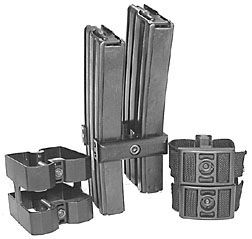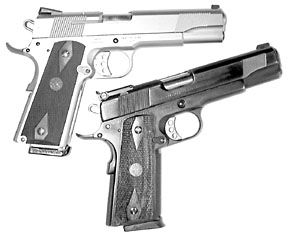AR-15 Mag Couplers: Double the Trouble, or Half the Reload Time?
recently purchased and tested three different magazine couplers designed to join two AR-15 magazines together as a high-capacity unit. From Brownells, (800) 741-0015, we ordered the First Samco Mag Coupler, $9.99, a one-piece reinforced polymer bracket; Buffer Technologies’s MagCinch, $19.95, which works by combining a polymer clamp with nylon straps; and the Mag Grip, $24.98, a machined-aluminum clamp.

Beyond the obvious advantages of putting more rounds at our fingertips, putting two mags together on the gun would, we thought, subtract weight from the belt, making room for other necessary items, and would add weight to the rifle, dampening recoil. The Mag Grip secured the magazines with a hefty Allen bolt. The remaining two couplers depended on slotted screws. Twenty-round magazines are mounted evenly, but longer 30-round magazines needed to be offset to clear the ejection port.
One unavoidable problem we found with the basic concept of tandem magazines was that the top most round in the magazine not in use was subject to shifting forward during recoil, making the reload tricky. The only answer we found was to insert the fresh magazine at an angle, leading with the front edge so that the tip of the offending round was pushed back into place as the magazine went in.
However, the biggest problem with our test products was slippage. As tight as we could make the Buffer Technology and First Samco pieces, the mags shifted when dropped or when used for support during prone shooting. Tack welding stops on the magazine bodies would cure this in each case, but we liked the Mag Grip best because it was the easiest to mount and made the strongest connection. Also, since it was all metal we could add a little Loc-Tite to contact surfaces for extra security.
Gun Tests Recommends
Buffer Technologies MagCinch, $19.95. Conditional Buy. Allowed slippage, but kept the mags together.
First Samco Mag Coupler, $9.99. Conditional Buy. Showed the same problems as the MagCinch, but was less expensive.
Mag Grip, $24.98. Our Pick. Pricey, but did the job better than the other couplers. —Roger Eckstine
———-
Valtro .45 Still Beats S&W’s New Semiauto
We recently tested two versions of the SW1911 (April 2003), and although we thought it was an okay gun, some of us had major problems with one aspect of it. On presenting the gun swiftly and attempting to make it go “bang,” we often found it impossible to press the trigger. The grip safety was not being depressed by the hand.
We actually tried two SW1911s, one in Texas and a second one in Idaho. Unlike the Texas gun, the Idaho version had a poor trigger pull. There were a few other items that we thought needed attention, and took it upon ourselves to get the job done properly.
Our goal was to see if the SW1911 could be made into a gun as good as our much-favored Valtro 1998 A1 without running over the cost of the latter, which is approximately $1200.
We sent the SW1911 to Ned Christiansen, proprietor of the innovative Michiguns Ltd. gun shop in Three Rivers, Michigan (www.m-guns.com; phone 269-273-4867), for a thorough going-over. To our satisfaction, Christiansen told us that he also could not reliably depress the Smith’s grip safety and make the gun fire every time. He is an active competitor in many events that require a good 1911, so his opinion meant a great deal to us. We told Ned to make the gun into one he would personally be willing to carry as a first-line defense pistol. With that in mind, he went over the entire SW1911.

Ned told us that the web of some hands (including his) would actually force the Smith’s grip safety upward harder than the palm was trying to push the safety forward, with the result that the safety was not deactivated, and the gun would not fire. Ned’s fix was to recontour the grip safety. He undercut it so the gripping hand would no longer shove it upward when pressure was applied. He had to recut the frame slightly where the two meet. He did this in such a manner, including refinishing, that we could not tell anything had been done.
That recontour entirely fixed the problem, but Ned did not stop there. He surface-ground a few thousandths off the width of the sear because it dragged in the frame. He deburred the inside of the mag well where the trigger cut threw burrs up, and shortened the protruding grip-mount bushings inside the magazine well to make sure nothing would drag during a reload. He deburred the “windows” beneath the grip panels, and the “knife edges” at the bottom of the disconnector hole. He dehorned the barrel bushing and extractor, and removed slight burrs from the barrel-locking lugs. He cut the firing-pin-block spring two coils, which left it functional, but slightly reduced the force needed to activate it. His recontouring made the grip-safety force relatively immaterial, because now we can depress the safety reliably, even with a slightly questionable grasp on the gun.
One item requires Ned’s personal comments, and that is the full-length slide-spring guide rod fitted by S&W and by many other 1911 makers. In Ned’s words, the full-length guide rod “…is a result of a mistaken perception that it does something. Entry-level users [of the 1911] think it’s a must, and S&W exhibited entry-level — not high-end — thinking by using this awful version that is nearly impossible to get out easily and safely.”
Christiansen replaced it with original GI-type parts that permit easy disassembly of the gun without tools, which is the way we think all serious 1911s ought to be set up. Ned also cleaned up a few other nooks and crannies in the gun that he thought needed attention. Finally, Ned gave the gun an outstanding trigger pull of 3.8 pounds, exactly what we had requested.
He test-fired the gun with 240 rounds of a variety of ammunition, most of it Cor-Bon’s huge-cavity jacketed loads, and had zero malfunctions. He achieved about the same accuracy we got, “the low side of 2 to 3 inches,” at 25 yards. He commented that he expected better accuracy, because the gun was fairly well fitted by S&W. Later, we recrowned the barrel, but this didn’t change the accuracy to any noticeable extent. The gun had enough accuracy for self-defense uses, so Ned did not try to improve it. One other thing Ned checked was the activation timing of the safety plunger, to see if it was possible to drop the hammer with the pin still locked. S&W recently issued a recall based on potential problems in this area, but our gun was okay.
The resultant gun looks exactly like it did when we sent it to him, but it is clearly a whole lot slicker. Empty mags drop free like they’re spring-loaded out of the gun. The gun fires every time we try, and the new trigger pull makes it into a handgun worthy of the S&W name. While the deburring may not have made an obvious difference, we’re glad it was done. We deburr our own guns routinely, as needed.
The Valtro 1998 A1
So how does the modified SW1911 stack up to the Valtro? (See the July 2002 GT for the full report.) And what would all this cost? Michigun Ltd.’s price for all the work was in excess of the difference in price between the Valtro (about $1200) and the S&W (MSRP $932, street price about $750-800). Though it’s vastly improved, our SW1911 still does not have the Valtro’s fine checkering on the front and rear straps, nor does it have the Valtro’s adjustable sights. The Valtro is more tightly fitted between frame and slide, and has a slight accuracy advantage. The Valtro has better overall deburring of the inside and outside of the gun, and the S&W still needs a bit more attention to make it as slick.
The Valtro has those lovely wood grips, and magnificent 30-lpi checkering on its forged frame. And it has a more comfortable, rounded-front, trigger with a perfect pull of 3.5 pounds. The Valtro weighs two ounces more than the Smith (36.7 vs. 34.7 ounces), much of it being in the mainspring housing, which on the Valtro is steel, but aluminum on the Smith. The Valtro does have a long slide-spring guide rod, but that can be easily changed. The Valtro also has a pinned front sight, another item the S&W lacks.
Gun Tests Recommends
Valtro is still the finest full-size 1911 pistol we’ve seen, and at the lowest price. We concluded the Italian-made Valtro 1998 A1 is the hands-down, clear-cut winner over the modified SW1911. —Ray Ordorica






























